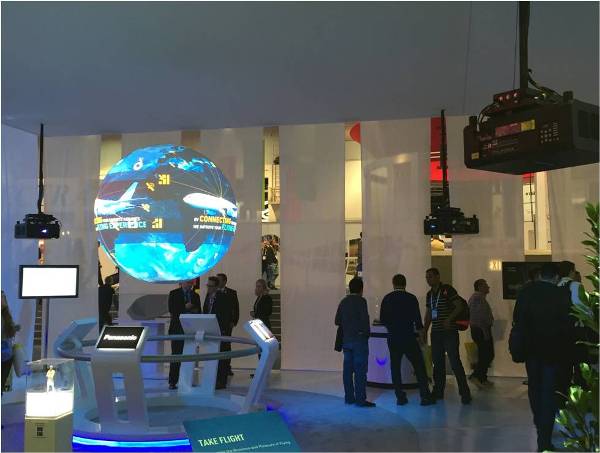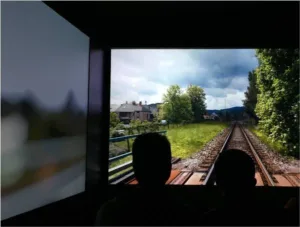Casio showed the new XJ-V2 hybrid laser projector with 3,000 lumens and XGA (1024 x 768) resolution. The projector is the second in the line of XJ-V projectors, with more to follow at a later date. The projector started shipping in December and is available for $699. Their main focus of the projector exhibit was to highlight the advantages of their hybrid laser light engine versus a lamp-based projector. In a side by side comparison of older Casio lamp based projectors with newer models they showed the fast on / off, long life time and lower power consumption of the laser phosphor solution compared to a traditional lamp. They demoed a 2010 projector with 18,000 h of operation next to a brand new one at basically the same brightness, while the power consumption of comparable brightness projectors is only about half for the laser phosphor solution.
Canon showed three projectors in a case without any more details or hints for new products on an exhibit that was dominated by camera products. They did however demo an 8K video experience to highlight their 8K camera by projecting their content on four 4K projectors. In addition they showed a side wall with low resolution and out of focus projection to increase the immersive effect of the demo. The content for the side walls was acquired with additional FHD cameras and projected by separate projectors.
The Sony booth highlighted more projection solutions than their competitors including using projectors to create a continuous video band on the upper portion of the booth walls. Unfortunately the projection was somewhat washed out, which took away from the experience. On the home theater front they showed two of their 4K projectors in a side by side configuration to create a high brightness (10,000 lumens) projection solution. While they did not mention that this is aiming to be a HDR projection solution, it gave the impression that this may have been one of the goals. For the living room. they showed their ultra short throw solution with light rejecting screen again as well as a brand new prototype the LSPX-1. This ultra short throw micro projector is aiming to be like a display companion for the living room that allows you to view content from your mobile device without connecting to the main screen. Nothing was published about the technical or cost details of the projector other than it is expected to be available in the summer of 2016. A very interesting concept indeed.

Ricoh showed a new projector that so far was only released in Japan and China and will be available in the USA later this year. The new model has a brightness of 2,500 lumens and FHD resolution. There is no price yet for this model, but in Japan the model costs about $1,000. The unique feature of this home projector is an exchangeable top plate to give it a unique look. This ranges from a three dimensional shaped wooden art piece to a white Hello Kitty plate.

Panasonic did not show any new projectors at the show, instead demoed on how to use projectors in more professional applications. One area showed a sphere with the world map projected onto and thus creating a globe. In addition this globe was able to show overlaid weather maps, flight routes and airplane status, etc. In another area they used the mapping technology to project on moving objects. This approach can be used for games on a table or in a retail environment. For example they showed a person wearing a white T-shirt adding red polka dots on the shirt, while the background was striped. One can imagine on how this could be used in a retail store. Don’t leave it to the imagination, just look at it. The implementation did suffer somewhat from low brightness, putting the person basically into a dark cage and taking away from the overall effect. See our report on Panasonic for more information on an active rear-projection screen. (Panasonic uses ‘Honeycomb’ for HDR – Has Cool Transparent TV)

Microprojectors were available in an almost endless stream of devices from almost every Shenzen booth that cluttered the CES show floor. Sifting through the massive showing of devices is impossible in the short time frame of the CES exhibition, but it is clear that there are only a much lower number of devices are actually sold by many resellers. It is also not easy to identify the real manufacturer as all of them claim they make the device themselves, even though the same device shows up in several places.
To get an idea of where the technology is at the moment I talked to a few suppliers (Telstar and Shenzen Meidi Electronic, as well as some others). In general, most of these microprojectors are sold with batteries that allow viewing a complete movie (2h typical battery life) even though at a slightly reduced brightness. When running on a charger, they produce typical in the range of 200 to 350 ANSI lumens with a resolution between 720p and 1080p (most use the 1280 x 800 DLP chip as image source). Some support 3D as well and come with included speakers. In most cases the literature goes after lumens in a very aggressive way by stating generous on-off measurements resulting in up to 900 lumens. While this is a little overkill in terms of embellishment, the picture quality is quite impressive and even the achieved brightness makes these device quite useful for a small business environment or mobile applications. The technology has developed quite nicely and is finding their application niches documented by increasing sales, mostly in Asia for the moment.
Cinemood is another very interesting development in bringing picoprojectors to the consumers. This new start up company provides a hardware and software / content bundle to the user. They aim at the younger kids to early teens to provide a toy, entertainment center and mobile TV at an affordable price. The affordable price of below $400 (early pricing during crowdfunding is $280) includes content stored on the device (16 GB included) as well as allowing the users to add apps and other content later.
The device offers only 25 lumens of brightness at nHD (640 x 360) resolution courtesy of a TI DLP chip. While this does not impress on the first view, the argument for using such a low brightness projector is influenced by the target audience. Children, especially at a younger age will want to look on where these images are coming from, an action that is definitely not advisable with a higher lumen output projector. There is also Bluetooth (control and external speakers) and WiFi (new content, video messaging and updates) included. All in all, this is a very interesting concept for addressing a niche market. With a crowd funding campaign in the works, the company is still looking for partners to bring this product to market. – NH
 Source: Cinemood
Source: Cinemood

